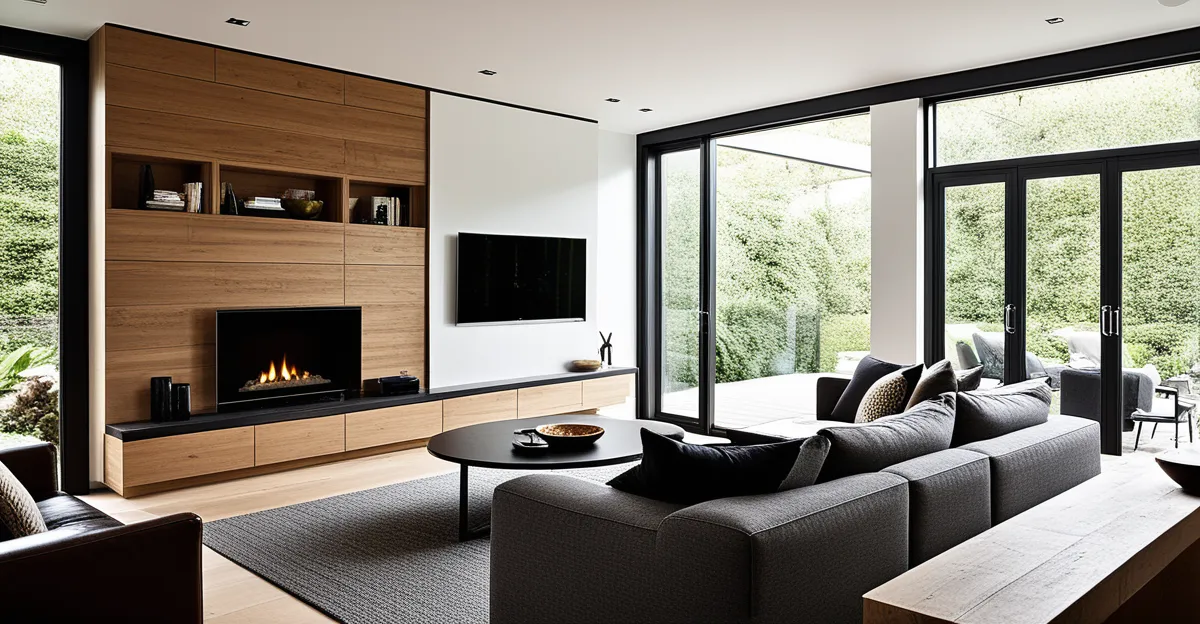Understanding Comfort in Living Spaces
Comfort in living spaces is a multidimensional concept that transcends physical ease to include emotional and mental well-being. At its core, comfort in home environments is defined by how personal spaces cater to individual needs, facilitating relaxation and promoting a sense of safety and peace. The psychological aspects of comfort play a pivotal role in one’s overall home well-being. By offering a sanctuary from the external world, these spaces help reduce stress and improve mood.
Multiple factors contribute to a sense of comfort, ranging from the temperature and lighting to the aesthetics of the surrounding environment. Personalization is key; when spaces reflect personal tastes and lifestyles, they inherently become more comforting. Additionally, the arrangement and functionality of living areas promote an inviting and harmonious atmosphere, further enhancing comfort and home well-being.
Also read : How Can Sustainable Home Practices Enhance Your Living Space?
As individuals increasingly view their homes as extensions of their identity, understanding the impact of psychological factors on comfort becomes crucial. Furniture that encourages relaxation, colors that evoke calmness, and decor that resonates personally are just a few elements that together weave the tapestry of a satisfying living environment. Therefore, recognizing and optimizing these aspects can lead to significantly improved comfort in living spaces.
Decluttering for Enhanced Comfort
Decluttering and adopting a minimalist approach can significantly enhance comfort in living spaces. Organized living is the foundation of a peaceful and comforting environment. When spaces are clutter-free, they promote relaxation and allow individuals to focus on what truly matters.
In parallel : How Can You Transform Your Living Space with Minimal Investment?
Benefits of Decluttering
By removing unnecessary items, you create more physical space, which can lead to improved mental clarity and reduce stress. A tidy environment aligns with the principles of minimalism, which emphasize simplicity and order. This approach not only fosters a serene atmosphere but also simplifies daily routines, making maintenance more manageable.
Strategies for Effective Decluttering
Effective decluttering involves categorizing and evaluating items based on their necessity and sentimental value. Start by tackling one room at a time, setting realistic goals. Donate or recycle items that no longer serve a purpose. Storage solutions, like baskets and bins, can help maintain the organization, ensuring everything has its place.
Minimalism’s Contribution to Comfort
Minimalism contributes to comfort by prioritizing the essential, which enhances the visual and psychological appeal of a space. A minimalist setting highlights key furniture pieces and decor items, enhancing their impact on the overall ambiance. This streamlined approach promotes a welcoming environment where one can unwind and feel at ease.
Choosing the Right Color Schemes
Color is more than just visual appeal; it is a powerful tool in shaping mood and enhancing comfort in living spaces. Understanding color psychology allows for more intentional home decor choices. Colors can evoke various emotions; for instance, blues and greens often create a calming effect, while reds and yellows might invigorate. Selecting the right color combinations can transform a room into a sanctuary of comfort and home well-being.
Recommended Color Palettes
Different areas of a home benefit from specific color palettes. For a serene bedroom, soft hues like lavender or muted blues are ideal. In contrast, warm tones such as terracotta or ochre are recommended for social spaces like living rooms to promote interaction and warmth. Incorporating neutral tones like greys or beiges can also provide balance and sophistication.
Color Trends for Comfort
Current color trends focus on creating cozy and inviting spaces. Earthy tones paired with subtle pastels are particularly popular, as they enhance warmth and comfort. For a more modern touch, accent walls in bold but soothing colors can add depth and intrigue without overwhelming the senses. By carefully selecting and combining colors, one can create a personalized, comforting environment tailored to individual preferences and needs.
Furniture Arrangement Strategies
Arranging furniture in your home can significantly enhance comfort and create a more inviting atmosphere. Thoughtful furniture layout ensures different areas of the room serve their purpose efficiently while uplifting the overall ambiance. When trying to optimize space, it’s important to focus on creating functional zones for activities like relaxing, chatting, or dining, ensuring each is distinctly defined yet cohesive.
Start by considering the best practices for arranging furniture aimed at comfort. Prioritize balance and flow, allowing for easy movement throughout the space. Avoid placing furniture pieces too closely together, which could create a cramped feel, and instead, experiment with angles to generate visual interest and a sense of openness.
To encourage conversation and connection, consider arranging chairs and sofas to face each other, forming an intimate and inviting setup. This strategy not only promotes social interaction but also enhances the room’s cozy appeal.
In smaller rooms, space optimization can be achieved through multi-functional furniture pieces, like ottomans or sectional sofas with built-in storage. Such items help maintain an organized environment without compromising on comfort or style.
Lighting Solutions to Improve Comfort
The role of lighting in enhancing comfort within living spaces cannot be overstated. Lighting design is essential not only for visibility but also for creating mood and ambiance. The right lighting can transform a room, making it feel more welcoming and cozy.
Natural Light
Natural light is a vital component of a comfortable living environment. It boosts mood and enhances the aesthetic appeal of a space. Whenever possible, design spaces to maximize exposure to natural light through strategic window placement and the use of sheer curtains. This approach not only improves home well-being but also reduces reliance on artificial light during the day.
Artificial Lighting Types
Diverse lighting types—ambient, task, and accent—each play unique roles in enhancing comfort. Ambient lighting provides overall illumination, setting the tone for a room. Task lighting is focused and functional, perfect for activities like reading, while accent lighting highlights features or artwork, adding a decorative layer.
Layering Lighting
For optimal ambiance, incorporate a mix of lighting sources. Layering involves combining various lighting types to create depth and warmth. Consider dimmable lights to adjust brightness levels based on time of day or mood. This strategy not only enhances the room’s coziness but also allows for flexibility in home decor.
Incorporating Textures and Layering
Textures play a significant role in enhancing the sensory and visual qualities of living spaces. By integrating textures in decor, homeowners can elevate comfort levels while adding depth and warmth to their environments. The key to mastering comfort through texture lies in selecting the right materials and effectively layering them for visual interest and coziness.
Comfort textiles like plush cushions, soft throws, and area rugs are essential. They not only contribute to a welcoming ambiance but also provide tactile enjoyment. Consider materials such as wool for warmth, linen for its breathable nature, and velvet for that luxurious touch.
Mixing various textures can create a compelling and harmonious look. Start with a base fabric and build by adding layers of different materials, ensuring to balance smooth and rough surfaces. This approach not only creates aesthetic appeal but also invites relaxation, making the space feel more intimate and inviting.
Incorporating a variety of textures can transform a room into a haven of comfort. By strategically using textures in your decor, you enhance both the visual interest and tactile appeal of your home, which significantly contributes to the overall sense of comfort and well-being.
Personalizing Your Space for Comfort
Creating a space that reflects your personality elevates home personalization and contributes to comfort decor. Personal touches, such as crafted items, cherished photos, or unique artwork, infuse warmth and familiarity into any room. This personalization not only enhances the aesthetic appeal but also provides emotional satisfaction and a stronger connection to one’s environment.
Personal items have a significant impact on comfort levels. They can evoke positive memories or create a sense of identity and belonging, directly influencing the psychological aspects of comfort. These elements can transform a physical space into a true sanctuary, promoting relaxation and reducing stress.
Consider incorporating personal touches that align with your passions or hobbies. Select decor pieces that tell your story—whether through travel souvenirs or DIY crafts—to make the space truly your own. This approach ensures your home is not just a place to live, but also a reflection of your unique journey and style.
DIY Projects for a Comfortable Living Space
Integrating DIY home projects into your living space can significantly enhance comfort without stretching your budget. These creative solutions not only improve aesthetics but also offer a personalized touch to your environment, making it truly your own. DIY endeavors allow for a custom atmosphere tailored to individual tastes, fostering a sense of achievement and pleasure.
To start, simple DIY projects such as creating homemade candles or building a cozy reading nook can instantly transform any area. These projects are not only budget-friendly but also bring a unique charm through personalized design. Repurposing old furniture with a fresh coat of paint or adding new hardware can breathe new life into your space without the cost of replacement.
When tackling creative solutions, consider each project’s functionality. For instance, constructing shelves or crafting storage boxes can address organization while enhancing decor. Incorporate multi-functional pieces that add both convenience and style.
For execution success, plan thoroughly by listing required materials and creating a timeline. Ensure you follow clear instructions or tutorials, keeping safety in mind. By approaching DIY projects with enthusiasm and care, you can enrich your home with innovative, comfortable features that reflect your personal flair.
Final Touches to Enhance Overall Comfort
Adding the right home accessories can transform a living space from merely functional to exceptionally cozy and inviting. Accessories such as throw pillows, decorative blankets, and art pieces enrich the aesthetic appeal and contribute to a harmonious environment that promotes well-being.
Recommendations for Cozy Home Accessories
Consider incorporating items that not only align with your personal taste but also enhance the warmth of your home. Popular options include:
- Soft textiles like faux fur or knitted throws that invite tactile interaction.
- Scented candles or diffusers that provide comforting aromas.
- Art and decor that reflects your personality, sparking joy each time you glance around.
These small details can significantly influence the mood, adding both comfort and character.
Creating a Harmonious and Inviting Environment
To achieve a balanced atmosphere, mix and match textures, colors, and patterns across accessories. Opt for a base palette that unites all elements, ensuring a cozy atmosphere that feels both deliberate and welcoming. By carefully selecting accessories, you create not only a stylish setting but also one that feels inherently restful and inviting. Accessorize with intention, and your living space can become the ultimate haven of comfort.

